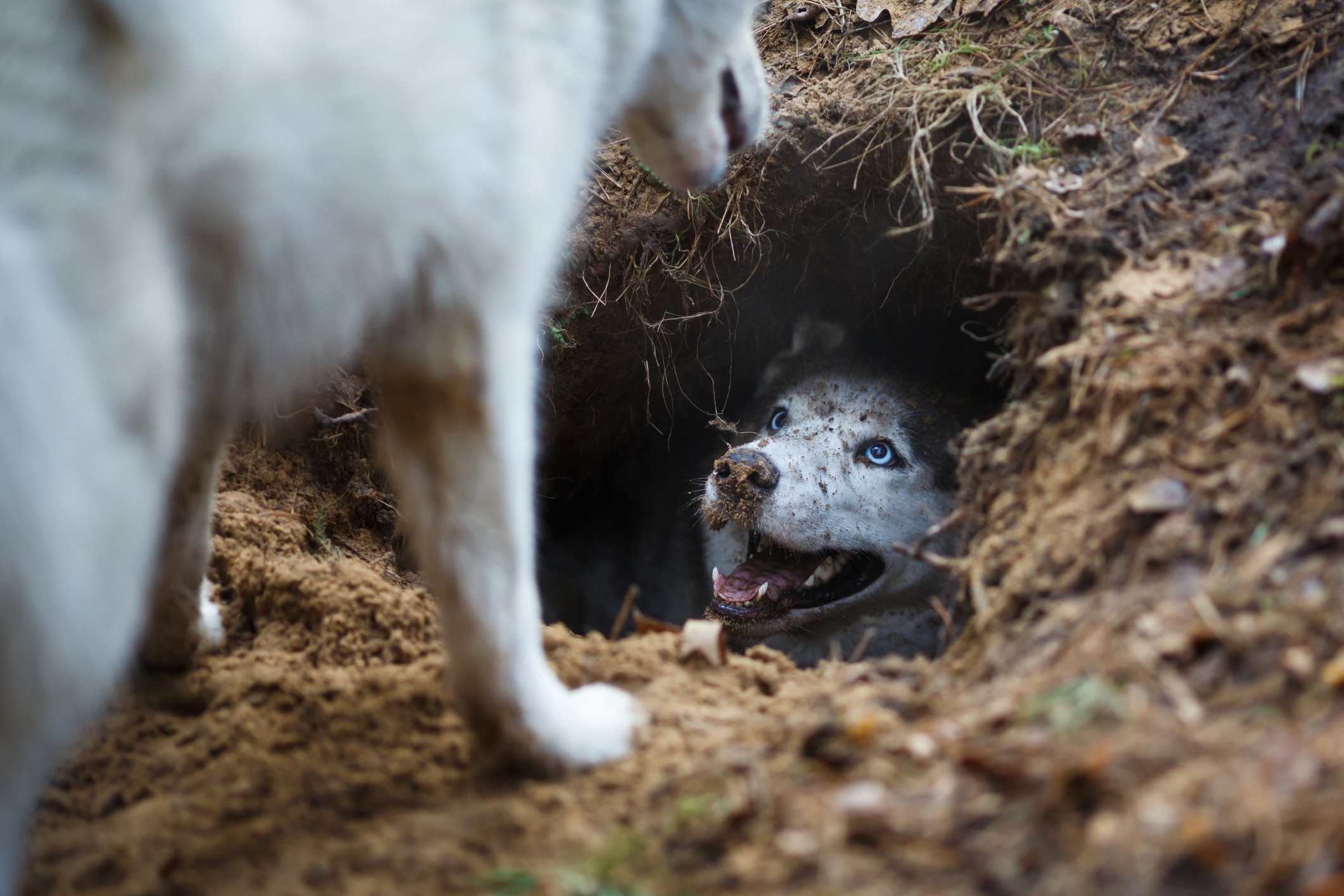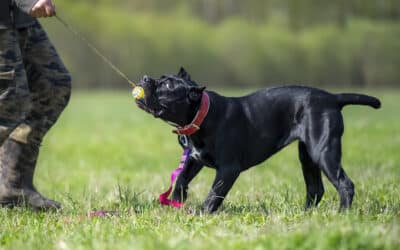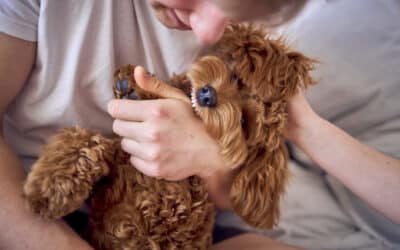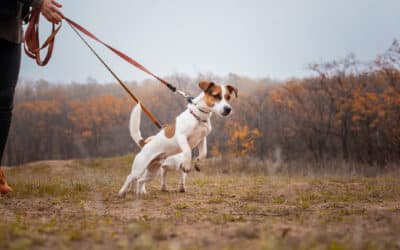Adding enrichment to your dog’s life is easier than you think! Many dog owners wonder whether they’re giving their dogs enough enrichment or how they can make them happier. At times, fitting enrichment and training into your own life can feel impossible, but I promise, it’s actually easy and you don’t need any extra time!
Once you learn how to see life from your dog’s perspective, enrichment becomes a breeze. In this post, we’ll talk about 3 ways you can easily make life better for your four-legged family member.
Let’s define Dog Enrichment
You may have often seen the word tossed around if you’ve looked into dog training or making your dog happy. Enrichment is a common term that trainers, vets, and other pet experts use to describe activities that make your pup’s life better.
At OneMind Dogs, we define enrichment as transforming your dog’s daily habits into enriching moments.
It helps turn things you already do with your dog into learning opportunities. You just need to understand how to give your dog a way to act on its natural instincts and to engage with you, so it can live in harmony with you and your family.
When owners don’t understand their dog’s perspective and don’t have a connection with their dog, dogs can start to behave in ways that often drive owners crazy. A bored dog can quickly become destructive, shredding your favorite shoes or even destroying the couch.
Dogs that aren’t getting enough or the wrong kids of exercise or mental stimulation will try to burn their energy on their own…and it’s usually ways that leave owners frustrated and overwhelmed. Biting, nipping, separation anxiety and jumping are all highly trainable behaviors that can be curbed through good enrichment.
Benefits of enrichment for dogs
- Helps you build a strong connection and relationship with your dog
- Helps prevent destructive and unwanted behaviors
- Offers mental stimulation that helps dogs feel more relaxed and happy
- Lowers stress levels so dogs aren’t over aroused as easily
- Builds your dog’s independence and self-confidence
Many dogs that are hyper and energetic need more mental stimulation than their owners realize; shy dogs or dogs with anxiety can also build self-confidence through the right enrichment activities.
Enrichment not only teaches dogs new skills but also helps them avoid distractions. No matter what your training goals are, the right techniques can help you live a better life with your dog. So here’s how you do it…
1. Learn what’s fun for your dog
The most important thing to do is learn what your dog enjoys. All too often, I see either the human having fun or the dog having fun, but not both of them! You need to know how to have fun with your dog, so you can give them enrichment they actually care about.
Think about what your dog looks like when it’s obvious they’re happy. This could be when they’re playing with other dogs or toys, spending time with you, or getting treats. Now harness that into something you can use as a reward. Not sure how? Learn more here!
Speaking of treats, make sure that you experiment with different rewards. Getting to visit the park, wrestle with you or go see a friend can be just as effective as food rewards. It’s all about what your dog finds valuable.
2. Create clarity in routine and training
How many times have you found yourself giving the same command over and over again while your dog stares at you with a blank expression? You might notice your pup even tunes out and ignores you.
One mistake many owners make is talking too much while they train. Instead, you can create clarity by focusing on engaging your dog and training from their perspective, so that what you are saying actually has meaning to them.
Dogs learn something every time they interact with us. It’s our job to make sure that we’re teaching them something meaningful.
Remember, daily habits are enrichment opportunities.
Whenever you are with your dog, focus on helping them to understand the rules, rewarding the things you like and making sure they don’t have the opportunity to behave in ways that you don’t like. Observe your dog’s behavior, be in the moment with them so you can capture all the great things your dog does and reward them. What you reward is what you get more of!
3. Focus on basic skills and make them enriching
There are a lot of suggestions about dog enrichment out there, but they can quickly become overwhelming. You don’t need to get complicated or fancy, focus on everyday skills that make your dog’s life more rewarding.
These are:
- Eye contact — Teach your dog how to hold eye contact whenever you ask for it and even better, encourage them to offer eye contact even without being prompted. This will improve their focus on you and help them better understand what you want them to do. Reward your dog with some of their daily meal or a cuddle or play session when they focus on you without being prompted.
- Recall — Dogs should learn to respond to their names in every situation. When you call them, they should stop whatever they’re doing and come to you. Teaching this skill is all about fun. Make it exciting for your dog! Getting to you should be rewarding, not the end of their fun. Never call them over to you when you’re angry or to scold them. Instead, have a game when they get to you, run away and encourage them to chase you for example!
- Staying put — Staying still when asked has many benefits during playtime, training, mealtime and walks. Pups with a lot of energy can especially benefit from learning when to calm down and stay put on command. Your visitors will thank you for having a dog that can switch off and chill out on command. Turn this into a fun activity by tossing your dog surprise treats whenever they are calmly relaxing on their own.
Tips for success in dog training
Use repetition
Consistency is key in successful dog training. Whenever your dog does something you like, reward them. Especially when teaching them something new, you must reward every time they perform the desired behavior.
The best way to set your dog up for success is to make learning new skills easy. Start at the very beginning and only move forward in very small steps. If there’s a mistake, go back a step. This also takes away all the stress and frustration on your end!
Remember to work slowly and take things step by step. It takes time, but the effort is worth it!
Go on structured walks
There are many ways to turn walks into learning moments. For starters, create a routine for going out that includes your dog. Rather than wrestling them into a harness, for example, teach them to love their harness by rewarding them every time they stick their head through the opening. Before you know it, they’ll be trying to put the harness on by themselves!
You can also make learning how to slip into their collar a fun game that gets them excited every time it’s time to leave the house.
Focus on training your dog to wait before they leave the house, and only exit the door when you give them permission. This helps them to start the walk focused on you, and can even be lifesaving for your dog at some point.
Every 5 minutes, try to do something fun. This can be practicing a trick, jumping on a bench, or stopping to play with a beloved toy. This is so important because it teaches your pup that you’re the ultimate source of fun!
Watch this video for some ideas:
Make enrichment a part of your routine
From walks to meals, you can make dog training something natural. When it’s time to eat, have your dog sit and wait until it’s released. On walks, have it navigate its way around trees, climb some steps, balance on a log or practice responding to its name.
When you incorporate new but consistent training into your routine, life is more exciting for your dog. Don’t be afraid to do this during different versions of your routine, like walking on a rainy day or going out in the snow.
Balance rest and activity
Just like humans, dogs need time to rest and de-stress. Your daily schedule should include plenty of time for your pup to use its mind as well as relax. For example, playing and going on walks are a good time for you to spend time together. But then, it’s important that your pup has time to rest and be on their own.
When your dog has balance, they can feel much more confident being alone while enjoying their time with us even more. Separation anxiety will become a thing of the past when your dog learns how to relax by themselves even when you are home.
Learn more with OneMind Dogs
Get detailed video instructions on these tips from Coach Noora Keskievari in our free webinar. Sign up to watch now!
And if you’re ready to dive deeper into training, you can join OneMind Dogs Puppy Training Program, which is perfect for older dogs too, it’s never too late to start over!
Our approach to training makes every moment a chance to deepen your bond with your pup.



